Customer feedback is the cornerstone of any successful business. It helps you drive important decisions, build relationships and keep up with customer needs and expectations. But, how do you know what type of customer feedback you should collect?
In this article, we’ll explore all the different types of customer feedback with pros and cons of each. By the end, you’ll have a good idea of which is right for your business. Let’s get started!
What are the two primary types of customer feedback?
The two main types of customer feedback are:
- Unsolicited feedback, where a customer shares their thoughts and opinions without you having to ask them. They can share this feedback directly to you (for example, in a conversation with customer support). However, they can also share feedback in an indirect way that you need to actively need to search for (like talking about your brand on social media)
- Feedback you ask for, through planned initiatives. These initiatives can run on an ongoing basis (for example, if you put a survey on your booking confirmation page) or be a planned event like customer interviews or focus groups.
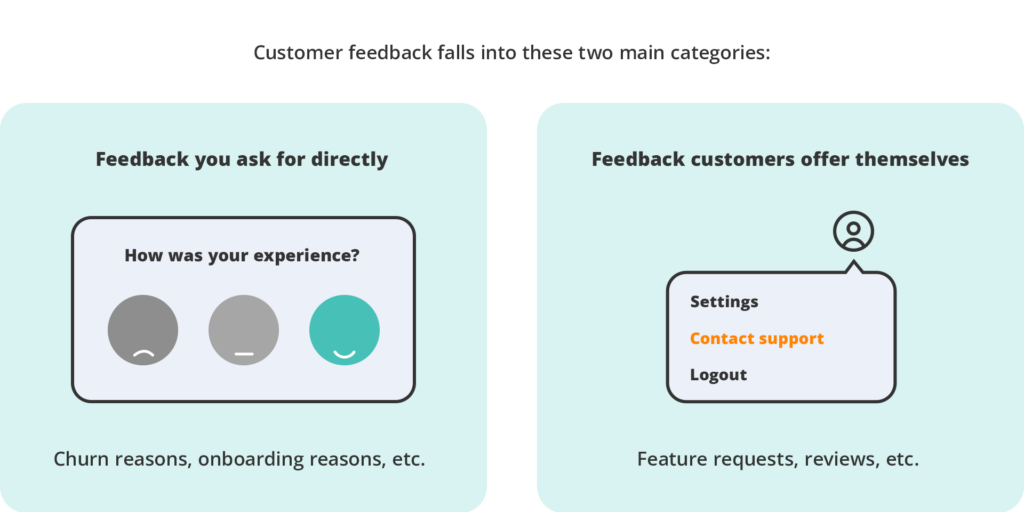
Which type of feedback is better?
Since it requires planning and is usually done in a structured way, it may seem like the feedback you ask for is more significant for your business. It’s certainly true that you can get great insights from direct feedback.
Because you have more control over how you receive feedback you ask for, it’s easier to get targeted data for particular topics. For example, say you’re a general manager at a hotel. You’ve noticed that only a small percentage of bookings include breakfast.
You could survey your guests and specifically include breakfast questions. You could ask how people who had breakfast felt about it. For everyone else, ask why they decided not to eat breakfast at the hotel. Their answers would give you actionable insights on how to increase breakfast bookings.
Because it is usually more organised, the feedback you ask for is easier to measure. You can use metrics like the Customer Effort Score, Customer Satisfaction Score or Net Promoter Score to keep track of your progress over time.
However, unsolicited feedback can be just as valuable. It gives you an honest look at how customers really feel about you, as they’re offering it without being prompted. The key is to organise this type of feedback in such a way that makes it easy to extract its value.
By studying both kinds of feedback closely, you’ll get a full understanding of what your customers need most, so you can make informed decisions and grow your reputation.
Customer feedback type #1: Feedback you get without asking
Let’s take a look at the first type of customer feedback: unsolicited feedback, which gives you valuable insights from customers without prompting from you.
Online reviews
While you may actively ask for reviews from your customers (and we strongly encourage you to do so), people can share their feedback freely online through review sites.
For physical items, there is often the option to do so directly on the website (like Amazon). For other kinds of businesses, customers might visit sites like Google or Yelp. There are also more specialised review portals for particular industries, like TripAdvisor for hospitality or Jameda for healthcare.
Pros of online reviews as a type of customer feedback:
- Easy to access – lots of people read and write online reviews, so you can get a lot of customer feedback without much effort
- Influential – positive reviews can help you gain new customers. Negative reviews can help you improve
- Unbiased – most people write reviews without being asked, so you get honest feedback about their experiences
- Wide reach – online reviews can be seen by lots of people, making them a low-effort way to reach potential customers you might not have found otherwise
Cons of online reviews:
- Not controlled – you can’t control what people say in their reviews or ensure they give you helpful feedback. You could even get poor ratings without an explanation for negative feedback
- Biased opinions – some customers might only write reviews when they’re very happy or very unhappy, so you might not get feedback representative of your average customer base
- Fake reviews – some businesses post fake reviews, either to look better or hurt their competition. This can make it difficult to trust the feedback, though thankfully it’s a rare practice these days
- Often difficult to analyse – reviews are fairly unstructured, making it harder to find patterns and trends without review management software like Customer Alliance
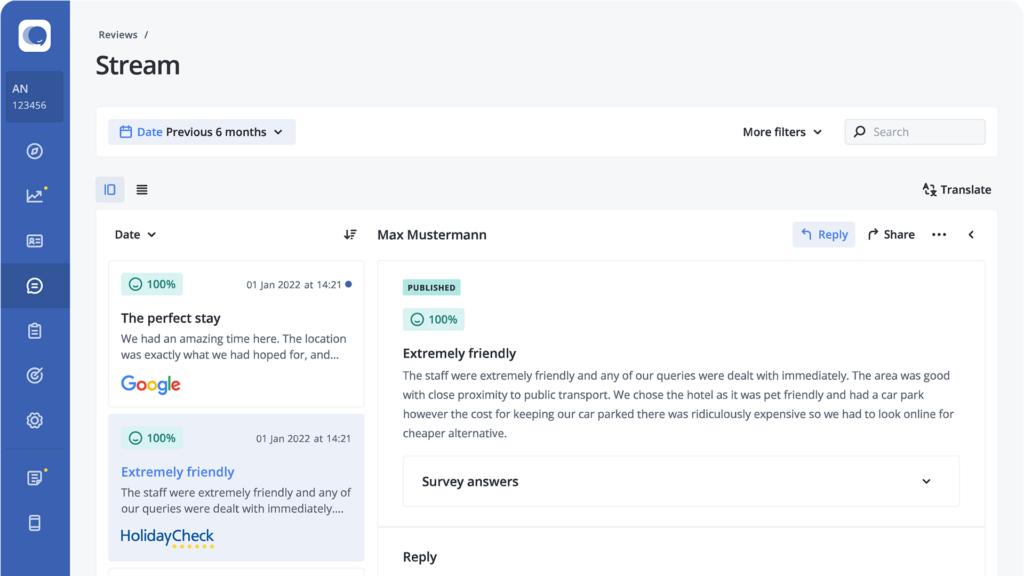
Feature Requests
Generally relating to digital products, feature requests are suggestions made by customers or users for new features, enhancements, or improvements.
Feature requests usually arise when a customer wants to do something with your product that isn’t currently possible.
For example, someone using productivity software might want to automatically add tasks to their Google calendar. If the software doesn’t allow it, they might contact the company (via the contact form, email or social media) to ask if they could add the feature in the future.
Pros of feature requests as customer feedback:
- Fresh ideas – your customers know what they want and can give you some great suggestions you might not have thought of
- Show you care – listening to and acting on feature requests shows customers you value their opinions and want to make their experience even better
- Keep up with the times – feature requests help you stay on top of trends and ensure your product or service stays relevant and competitive
- Improve your product – by adding features your customers want, you can make your product or service even more amazing and keep them coming back for more
Cons of feature requests:
- Too many cooks – sometimes, you’ll get a ton of different feature requests, and it can be tough to prioritise
- Not always realistic – some feature requests might be too hard or expensive to implement, or they might not fit with your overall vision or goals
- Can’t please everyone – even if you add a feature someone requested, it might not make all your customers happy. You’ve got to find the right balance between pleasing different customers and staying true to your brand
Customer complaints
Customer complaints can come through many different channels. In most cases, you’ll get them in person, or through email or phone conversations with customer service. However, customers can also complain on public forums like social media or forums.
No one wants negative customer feedback. But look on the bright side! Unhappy customers can offer hugely valuable feedback that helps you improve your business. If you deal with complaints in the right way, you may even turn the customer experience around.
Pros of customer complaints as a type of feedback:
- Fix the issues – complaints help you spot problems you might not know about, so you can fix them and make your customers happier
- Learn and grow – by understanding what went wrong, you can learn from your mistakes and avoid making them again in the future
- Show you’re listening – responding to complaints and solving issues shows people you care about their customer experience and want to improve it
- Turn frowns upside down – sometimes, fixing a complaint can turn a dissatisfied customer into a loyal fan who’s impressed with how you handled the situation
Cons of customer complaints as a type of feedback:
- Hard to hear – nobody likes negative feedback, and it can be upsetting to deal with complaints
- Not always fair – some complaints might be more about the customer’s personal preferences than a real issue with your product or service.
- Can’t please everyone – you might not be able to fix every complaint or make every customer happy, and that’s okay. Focus on the issues you can solve and learn from the rest
Social media mentions
Social media mentions are when a customer talks about your business on social media platforms like Facebook, Twitter, Instagram or LinkedIn.
Often, the customer will tag your business in the post so you get an alert that someone has mentioned you. However, sometimes they’ll only refer to you by name, meaning you have to actively look for what’s been said.
We’ve all heard stories of bad customer experiences that blew up online, but fortunately, that’s a rare occurrence. Most social media mentions are perfectly manageable and play a key role in your customer feedback strategy.
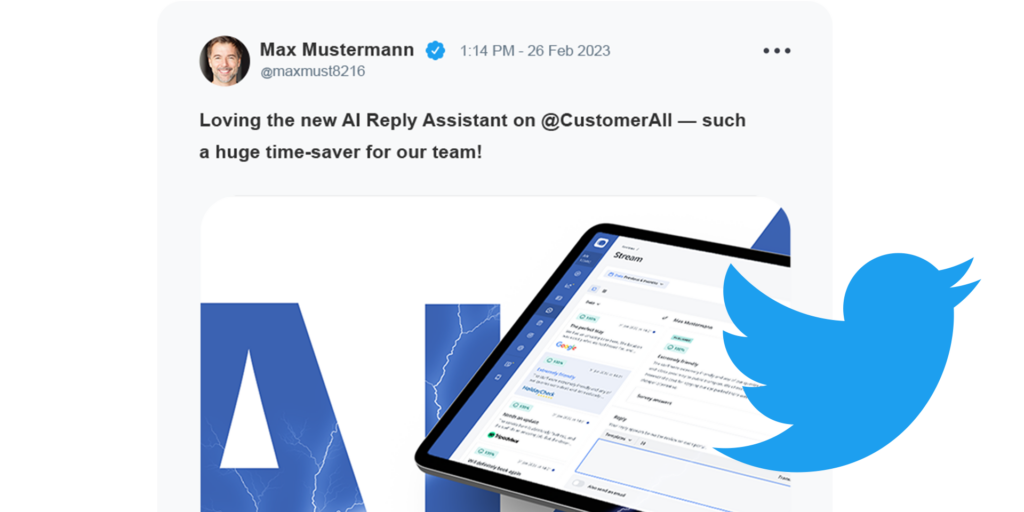
Pros of social media mentions:
- Real-time feedback – people often share their thoughts on social media as they experience your product or service, so you get fast and up-to-date feedback
- Wide reach – many people use social media, so you can hear from a large and diverse group of customers
- Easy to track – tools are available to help you monitor mentions of your brand, making it easy to see what people are saying
- Unprompted opinions – people share their thoughts on social media without being asked, so you get honest and natural feedback
Cons of social media mentions as a form of feedback:
- Negative bias – people might be more likely to post about negative experiences than positive ones, so you may find more negative feedback
- Hard to analyse – social media feedback can be unstructured and messy, making it harder to analyse and find patterns compared to surveys or interviews
- Not representative – the people who post on social media might not represent all of your customers, so you might not get a complete picture of their opinions
- Time-consuming – monitoring social media and responding to mentions can take a lot of time and effort, especially if your brand gets lots of attention
Website analytics
Website analytics are a really underrated way of getting feedback (without anyone having to tell you a thing!)
Understanding why visitors do the things they do on your website can directly inform webpage improvements. Your website is often the first experience a person has with you, so making positive changes will turn more casual visitors into fully-fledged customers.
Start small by looking at metrics like page bounce rate or time spent on a specific page. For example, if you notice your demo booking page has a low session duration, you could revisit the copy or design to see if you can convince people to stick around.
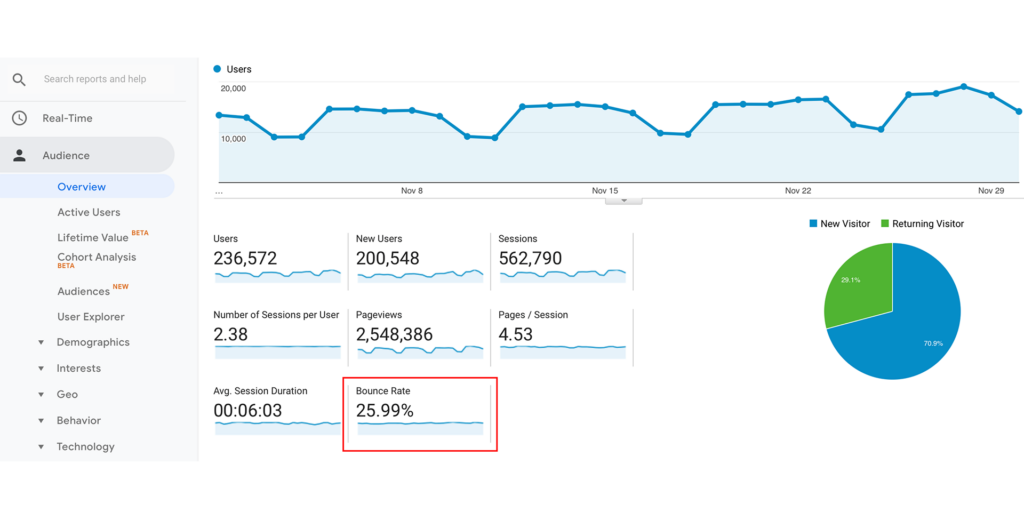
Pros of using website activity as customer feedback:
- Real-time insights – you can see what people are doing on your site right now, which can help you make quick decisions and improvements
- Actions speak louder than words – you can learn what customers really think by seeing how they use your site, in a way that they might not have communicated to you in words
- Data, data, data – website activity gives you quantitative feedback to analyse, which can help you make data-driven decisions
- Easy to track – there are loads of tools that can help you track and analyse website activity, so you don’t have to be a tech whiz to get started
Cons of website activity:
- Can be overwhelming – there’s a lot of data to look at, and it can be tricky to figure out which bits are most important or useful (Google Analytics for Beginners is a great place to start learning)
- Not always clear – website activity doesn’t always give you a direct answer about why customers are doing what they’re doing. You might need to dig deeper to understand the reasons behind their actions
- Needs context – website activity alone might not give you the full picture. You might need to combine it with other types of feedback to get a better understanding of what your customers want and need
Bug reports
Typically related to software or apps, bug reports are where users log an issue, error or unintended behaviour.
Bug reports generally include a description of the problem, steps to reproduce it, and any relevant screenshots or logs to help developers diagnose the issue.
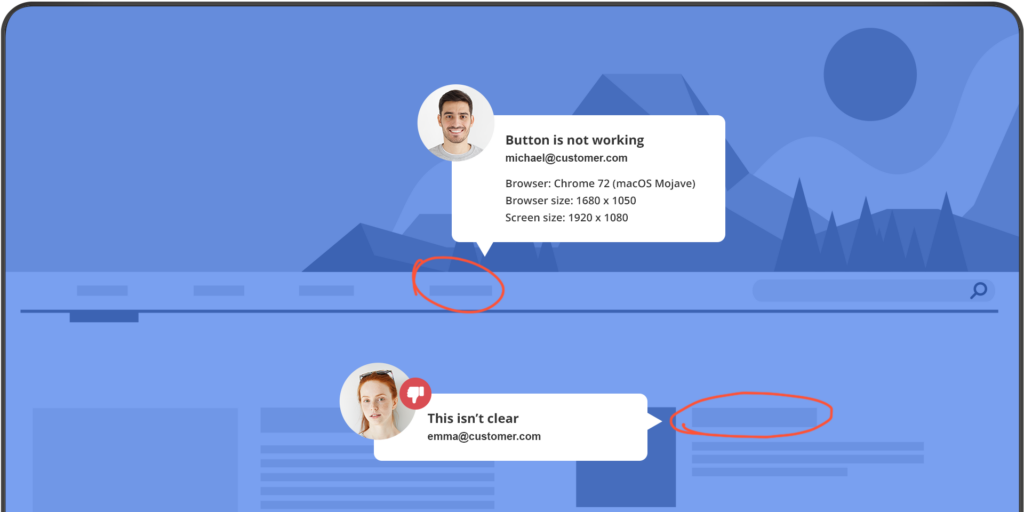
Pros of using bug reports as feedback:
- Identify issues – bug reports assist you in discovering problems that may have gone unnoticed, allowing you to address them and improve your product or website
- Satisfied customers – resolving bugs leads to a more seamless user experience, increasing customer satisfaction. This increases the likelihood that they will become loyal customers and recommend your business to others
- Learn from errors – by understanding the cause of issues, you can learn from your mistakes and prevent them from occurring in the future
- Prioritise resolutions – bug reports can help you determine which problems are most pressing, enabling you to address them in a strategic way for maximum impact
Cons of bug reports:
- Can be disheartening – it’s not fun to hear about issues, and managing bug reports can be somewhat discouraging
- Time-consuming – addressing bugs can require significant time and resources, which may necessitate postponing other important projects
- Challenging to resolve – some bugs may be difficult or costly to fix. This might mean a careful evaluation of the costs and benefits before you start working on them
Conversations with customer support teams
Support teams often get the most feedback from customers as they spend so much of their day in direct contact with them. Even if a customer is just calling to ask for help, there’s usually some kind of feedback your team can take from that customer service interaction.
For example, say you run a hotel and a customer calls to ask when the money will be deducted from their card for their reservation. This tells you that your booking page might not be clear enough, and one small tweak will make for more happy customers.
Pros of feedback from customer support conversations:
- Direct feedback – talking with customers one-on-one gives you immediate and specific feedback about their experiences
- Build relationships – helping customers with their issues makes them feel valued and improves their loyalty to your brand
- Identify trends – if many customers have the same problem or question, it could be a sign that you need to make changes or improvements.
- Train your team – learning from customer support interactions can help you train your team to provide better service that leads to more positive feedback
Cons:
- Time-consuming – answering customer support requests takes time and effort, especially if you get a lot of them
- Can be negative – support interactions often focus on problems or complaints, so you might not hear much about what customers like or what’s working well
- Biased sample – the people who contact your support team won’t necessarily represent all of your customers, so their feedback might not give you a complete picture
- Limited scope – customers might only give feedback about specific issues they have, so you might not learn about other areas that you could improve
Customer feedback type #2: Feedback you ask for
Now let’s take a look at the other type of feedback — feedback you ask for. You get this feedback from planned initiatives that range in complexity from an informal survey to a complete, multi-channel customer feedback strategy.
Customer surveys
Customer surveys are sets of questions that you give to customers to find out what they think about your products, services, or overall experience.
These surveys can be online, on paper, or even over the phone. The idea is to get a large amount of feedback from lots of people, so you can figure out what’s working, what’s not, and how you can make things even better for your customers.
Surveys can have all kinds of questions, including multiple-choice questions or open-ended questions where people can share their thoughts in their own words. You can also measure customer satisfaction metrics like NPS, CSAT and CES from within your surveys.
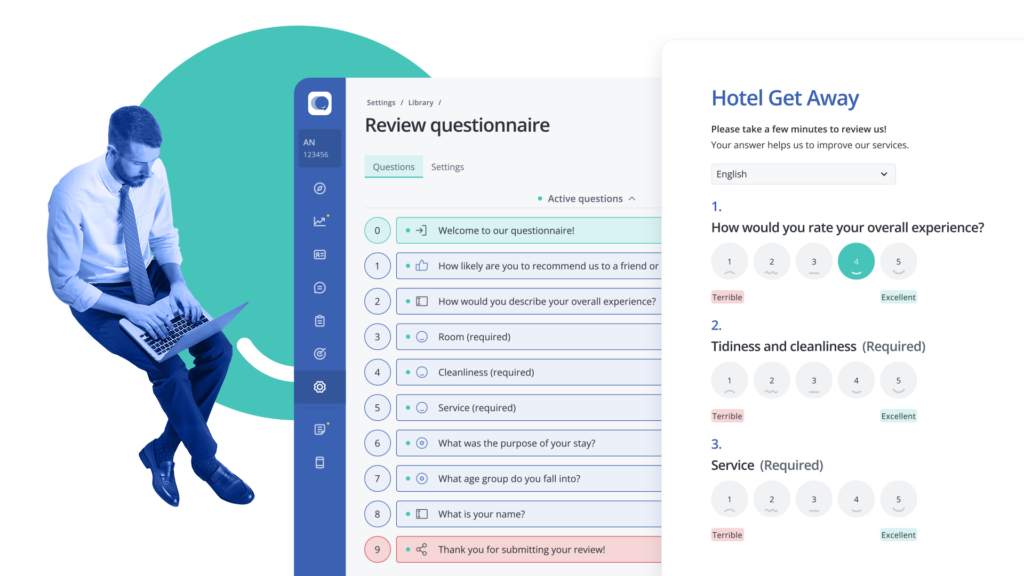
Pros of customer surveys:
- Lots of people – You can send a single customer survey to many people, which helps you get data from a bigger and more diverse group. As surveys are available in so many different formats, it’s easy to reach your customer base
- Inexpensive – Online surveys are usually cheap, making them a good choice for getting feedback without spending too much
- Easy to look at the results – You can use numbers and statistics to understand survey answers, which makes finding trends easier
- People can be honest – if surveys are anonymous, people might be more likely to share their real thoughts so you always get authentic feedback
Cons of customer surveys:
- Not very detailed – Surveys often have limited questions to encourage people to respond. As a result, if you don’t design your survey well you might not get deep information like you would from focus groups or interviews
- Not everyone answers – some people might ignore or not finish surveys, so you might not get as much data as you want.
- Biased answers – if you word questions in a certain way or give specific answer choices, it can affect how people answer and make your results less accurate.
- People might not understand – if people can’t ask questions, they might not understand what you’re asking and give answers that aren’t helpful (or abandon the survey altogether)
Focus Groups
Focus groups are gatherings of a small group of customers or potential customers who are brought together to discuss and provide feedback on a specific product, service, or concept.
These discussions are usually guided by a moderator, who encourages participants to share their thoughts, opinions, and experiences in a structured yet open environment.
What’s great about focus groups:
- Rich insights – focus groups can provide you with detailed information about customer opinions and preferences. It’s a great way to dive deep into how people feel about your product or service
- Observing group dynamics – in a focus group, you can observe how customers interact with one another, which might reveal useful insights about their collective thoughts and shared experiences
- Real-time feedback – since focus groups happen live, you get to hear customer opinions as they discuss your product or service, allowing you to ask follow-up questions and get immediate clarifications
- Nonverbal cues – by observing body language and facial expressions, you can gather additional information about how customers feel that you can’t get from written feedback
The downsides of focus groups:
- Cost and time – focus groups can be expensive and time-consuming to set up, especially if you need to hire a professional moderator, rent a venue, or provide incentives for participants
- Limited representation – since focus groups usually involve a small number of people, the feedback you get might not be representative of your entire customer base. This could lead to skewed results
- Groupthink – sometimes, participants in a focus group might be influenced by the opinions of others, which could affect the authenticity of their feedback. It’s important to watch out for this as it will have a negative impact on the whole initiative
- Skilled moderation required – to make sure the discussion stays on track and everyone gets a chance to speak, you’ll need a skilled moderator. Otherwise, you might end up with a few dominant voices that overshadow the rest
Customer Interviews
Customer interviews are one-on-one conversations between a member of staff and a customer or potential customer.
The purpose of these interviews is to gather in-depth feedback, opinions, and insights about your products, services, or overall customer experience.
Pros of customer interviews for feedback:
- Get deep information – talking with customers one-on-one lets you ask more detailed questions and get more in-depth answers
- Clear up confusion – if customers don’t understand a question, you can explain it to them, so their answers are more helpful
- Build relationships – interviews can help you connect with customers and make them feel valued, which can improve customer loyalty and generate positive feedback
- Flexibility – you can change your questions or ask follow-up questions based on the customer’s answers, making interviews more flexible than surveys
Cons:
- Time-consuming – interviews can take a lot of time to set up, conduct, and analyse, especially if you talk to lots of people
- More expensive – interviews usually cost more than other methods like surveys because they need more resources and effort
- Not as many people – you can’t interview as many customers as you can with surveys, so your results might not represent everyone’s opinions
- Skilled interviewer needed – you need someone who’s good at asking questions and making people feel comfortable, or the interview might not go well
Usability Tests
Usability tests are when real users try out a product, service, or digital interface (like a website or app) in a controlled setting.
The main goal of usability testing is to see how easy it is to use, how well it works, and what the overall user experience is like.
During the test, users do specific tasks or explore certain features, while the testers watch what they do, collect feedback, and spot any problems or issues that come up.
Pros of usability tests and customer feedback:
- Spot issues – usability testing helps you find problems with your product or design that you might not notice otherwise
- Improve user experience – watching customers use your product lets you see what works well and what doesn’t, so you can make improvements
- Get detailed feedback – you can ask customers questions during usability testing to understand their thoughts and feelings better
- Save time and money – fixing issues early on can save you time and money, instead of making changes after your product is already out
Cons:
- Takes time – usability testing can be time-consuming, especially if you need to test with many people or do multiple rounds of testing
- Can be expensive – depending on the size and scope of your test, usability testing can be costly, especially if you need to hire professionals or provide incentives for participants
- Small sample size – you usually test with a small group of people, so their feedback might not represent all of your customers’ opinions
- Skilled facilitator needed – you need someone who’s good at guiding the test and making people feel comfortable, or the results might not be helpful
Explore different types of customer feedback to create better customer experiences
In conclusion, there are many ways to gather customer feedback, and each method comes with its own set of pros and cons.
Whether you’re using focus groups, customer interviews, surveys, usability tests, or any other approach, the key is to listen to what your customers have to say and use their feedback to make improvements.
By doing so, you can create better products, services, and experiences that’ll keep your customers coming back for more.
